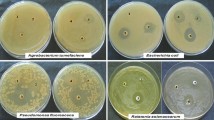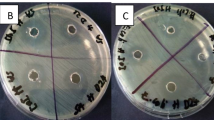Abstract
The growing concern for allopathic system, due to its side effect have gained the attention of researchers towards the exploration of traditional herbal system. Anethum graveolens L. (dill) is one of the widely utilized aromatic plant, due to its various therapeutics and other applications. Both the seeds as well leaves of the plant are explored for different applications. The secondary metabolites of A. graveolens have been explored for their biological properties due to its aroma and source of several bioactive metabolites. Here, we have characterized the volatile compounds of A. graveolens from seeds and elucidated their antimicrobial properties. The solvent extraction of fine powder of seeds was performed. The fractions containing different secondary metabolites were evaluated for their antimicrobial activity against bacterial and fungal pathogens. Further, GC–MS analysis of hexane fraction and 70% methanol led to the identification of limonene, cyclohexanone, apiol, tetracontane, β-myrcene and α-pinene whereas the methanol fractioned contained olic acid, hexadecane, hetpacosane, apiol, and octadecane 1-chloro compounds as major constituents.



Similar content being viewed by others
Data availability
Data can be made available on the request.
References
Aati HY, Perveen S, Aati S, Orfali R, Alqahtani JH, Al-Taweel AM, Wanner J, Aati AY (2022) Headspace solid-phase microextraction method for extracting volatile constituents from the different parts of Saudi Anethum graveolens L. and their antimicrobial activity. Heliyon 8(3):e09051
Adams RP (2007) Identification of essential oil components by gas chromatography/mass spectrometry, vol 456. Allured publishing corporation, Carol Stream
Aggarwal KK, Khanuja SPS, Ahmad A, Santha Kumar TR, Gupta VK, Kumar S (2002) Antimicrobial activity profiles of the two enantiomers of limonene and carvone isolated from the oils of Mentha spicata and Anethum sowa. Flavour Fragrance J 17(1):59–63
Alamgir ANM (2017) Therapeutic use of medicinal plants and their extracts:, vol 1. Springer International Publishing AG
Al-Oqail MM, Farshori NN (2021) Antioxidant and anticancer efficacies of anethum graveolens against human breast carcinoma cells through oxidative stress and caspase dependency. BioMed Res Int 2021:1–12
Amin WM, Sleem AA (2007) Chemical and biological study of aerial parts of dill (Anethum graveolens L.). Egypt J Biomed Sci 23:73–90
Bahramikia S, Yazdanparast R (2009) Efficacy of different fractions of Anethum graveolens leaves on serum lipoproteins and serum and liver oxidative status in experimentally induced hypercholesterolaemic rat models. Am J Chin Med 37(04):685–699
Bower A, Marquez S, de Mejia EG (2016) The health benefits of selected culinary herbs and spices found in the traditional Mediterranean diet. Crit Rev Food Sci Nutr 56(16):2728–2746
Chaubey MK (2007) Insecticidal activity of Trachyspermum ammi, Anethum graveolens and Nigella sativa essential oils against stored-product beetle Tribolium castaneum. Afr J Agric Res 2:596–600
Chen Y, Zeng H, Tian J, Ban X, Ma B, Wang Y (2014) Dill (Anethum graveolens L.) seed essential oil induces Candida albicans apoptosis in a metacaspase-dependent manner. Fungal Biol 118(4):394–401
Delaquis PJ, Stanich K, Girard B, Mazza G (2002) Antimicrobial activity of individual and mixed fractions of dill, cilantro, coriander and eucalyptus essential oils. Int J Food Microbiol 74(1–2):101–109
Evergetis E, Michaelakis A, Haroutounian SA (2013) Exploitation of Apiaceae family essential oils as potent biopesticides and rich source of phellandrenes. Ind Crops Prod 41:365–370
Farnsworth NR, Soejarto DD (1991) Global importance of medicinal plants. Conserv Med Plants 26(26):25–51
Goodarzi MT, Khodadadi I, Tavilani H, Oshaghi EA (2016) The role of Anethum graveolens L. (Dill) in the management of diabetes. J Tropic Med 2016:1–11
Gupta R, Answer MM, Sharma YK (2012) Dill. In Handbook of Herbs and Spices. Woodhead Publishing, pp 275–285
Haidari F, Zakerkish M, Borazjani F, Angali KA, Foroushani GA (2020) The effects of Anethum graveolens (dill) powder supplementation on clinical and metabolic status in patients with type 2 diabetes. Trials 21(1):1–11
Hajji M, Falcimaigne-Gordin A, Ksouda G, Merlier F, Thomasset B, Nasri M (2021) A water-soluble polysaccharide from Anethum graveolens seeds: structural characterization, antioxidant activity and potential use as meat preservative. Int J Biol Macromol 167:516–527
Hernández-Cánovas JD, Guillén-López I, Vizcaíno-Milla P, Andreo-López MI, Sánchez-Rubio M, Taboada-Rodríguez A, Marín-Iniesta F (2020) Antimicrobial activity of Citrus spp. and Anethum graveolens components against Candida metapsilosis in ranch sauce. J Food Sci Technol 57(7):2713–2721
Holley J and Cherla K (1998) Medicinal plants sector in India: a review
Itokawa H, Shi Q, Akiyama T, Morris-Natschke SL, Lee K-H (2008) Recent advances in the investigation of curcuminoids. Chin Med 3(1):1–13
Jana S, Shekhawat GS (2010) Anethum graveolens: An Indian traditional medicinal herb and spice. Pharmacognosy Rev 4(8):179
Jirovetz L, Buchbauer G, Stoyanova AS, Georgiev EV, Damianova ST (2003) Composition, quality control, and antimicrobial activity of the essential oil of long-time stored dill (Anethum graveolens L.) seeds from Bulgaria. J Agric Food Chem 51(13):3854–3857
Karimi K, Arzanlou M, Pertot I (2016) Antifungal activity of the dill (Anethum graveolens L.) seed essential oil against strawberry anthracnose under in vitro and in vivo conditions. Arch Phytopathol Plant Protect 49(19–20):554–566
Kaur GJ, Arora DS (2009) Antibacterial and phytochemical screening of Anethum graveolens, Foeniculum vulgare and Trachyspermum ammi. BMC Complement Altern Med 9(1):1–10
Lazutka JR, Mierauskien J, Slapšyt G, Dedonyt V (2001) Genotoxicity of dill (Anethum graveolens L.), peppermint (Mentha× piperita L.) and pine (Pinus sylvestris L.) essential oils in human lymphocytes and Drosophila melanogaster. Food Chem Toxicol 39(5):485–492
Lukubye B, Ajayi CO, Wangalwa R, Kagoro-Rugunda G (2022) Phytochemical profile and antimicrobial activity of the leaves and stem bark of Symphonia globulifera Lf and Allophylus abyssinicus (Hochst.) Radlk. BMC Complement Med Therapies 22(1):1–20
Ma B, Ban X, Huang B, He J, Tian J, Zeng H, Chen Y, Wang Y (2015) Interference and mechanism of dill seed essential oil and contribution of carvone and limonene in preventing sclerotinia rot of rapeseed. PLoS ONE 10(7):e0131733. https://doi.org/10.1371/journal.pone.0131733
Mohammed FA, Elkady AI, Syed FQ, Mirza MB, Hakeem KR, Alkarim S (2018) Anethum graveolens (dill)—a medicinal herb induces apoptosis and cell cycle arrest in HepG2 cell line. J Ethnopharmacol 219:15–22
Nair R, Chanda S (2007) Antibacterial activities of some medicinal plants of the western region of India. Turk J Biol 31(4):231–236
Nam H-H, Nan L, Choo B-K (2021) Anti-inflammation and protective effects of Anethum graveolens L. (Dill seeds) on Esophageal mucosa damages in reflux esophagitis-induced rats. Foods 10(10):2500
Ninou EG, Mylonas IG, Tsivelikas AL, Ralli PE (2017) Phenotypic diversity of Greek dill (Anethum graveolens L.) landraces. Acta Agric Scandinavica Sect B 67(4):318–325
Ozliman S, Yaldiz G, Camlica M, Ozsoy N (2021) Chemical components of essential oils and biological activities of the aqueous extract of Anethum graveolens L. grown under inorganic and organic conditions. Chem Biol Technol Agric 8(1):1–16
Panda S (2008) The effect of Anethum graveolens L. (dill) on corticosteroid induced diabetes mellitus: involvement of thyroid hormones. Phytother Res 22(12):1695–1697
Saleh-E-In MM, Choi YE (2021) Anethum sowa Roxb. ex fleming: a review on traditional uses, phytochemistry, pharmacological and toxicological activities. J Ethnopharmacol 280:113967
Salwan R, Sharma V, Sharma A, Singh A (2020) Molecular imprints of plant beneficial Streptomyces sp. AC30 and AC40 reveal differential capabilities and strategies to counter environmental stresses. Microbiol Res 235:126449
Shafaei A, Nejati M, Yusoff YM (2020) Green human resource management: a two-study investigation of antecedents and outcomes. Int J Manpower 41(7):1041–1060
Stavri M, Gibbons S (2005) The antimycobacterial constituents of dill (Anethum graveolens). Phytother Res 19(11):938–941
Talebi F, Malchi F, Abedi P, Jahanfar S (2020) Effect of dill (Anethum Graveolens Linn) seed on the duration of labor: a systematic review. Complement Ther Clin Pract 41:101251
TavakkolAfshari HS, Tabrizi MH, Ardalan T, Anoushirvani NJ, Mahdizadeh R (2022) Anethum graveolens essential oil nanoemulsions (AGEO-NE) as an exclusive apoptotic inducer in human lung adenocarcinoma (A549) Cells. Nutr Cancer 74(4):1411–1419
Tripathi AK, Prajapati V, Aggarwal KK, Kumar S (2001) Insecticidal and ovicidal activity of the essential oil of Anethum sowa Kurz against Callosobruchus maculatus F. (Coleoptera: Bruchidae). Int J Trop Insect Sci 21(1):61–66
Author information
Authors and Affiliations
Corresponding author
Ethics declarations
Conflict of interest
All the authors declare no conflict of interest in any capacity.
Additional information
Publisher's Note
Springer Nature remains neutral with regard to jurisdictional claims in published maps and institutional affiliations.
Supplementary Information
Below is the link to the electronic supplementary material.
Rights and permissions
Springer Nature or its licensor (e.g. a society or other partner) holds exclusive rights to this article under a publishing agreement with the author(s) or other rightsholder(s); author self-archiving of the accepted manuscript version of this article is solely governed by the terms of such publishing agreement and applicable law.
About this article
Cite this article
Sharma, R., Salwan, R., Sharma, M. et al. Biochemical characterization of volatile compounds and antimicrobial activity of Anethum graveolens seeds. Vegetos (2023). https://doi.org/10.1007/s42535-023-00641-1
Received:
Revised:
Accepted:
Published:
DOI: https://doi.org/10.1007/s42535-023-00641-1




